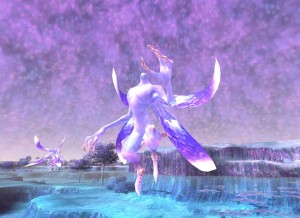Oh hi, readers! It’s that time yet again, my friends! For those just joining us, I have previously explored the NES, SNES, and PS1 eras of the Final Fantasy series in previous editorials. With the 1990s behind us, let us now turn to the PlayStation 2 days of gaming and the three series entries that resulted.
Final Fantasy X brought the series to the sixth generation of gaming consoles in July of 2001. Released in December 2001 in North America, Final Fantasy X was notably the first game in the series to feature voice acting; receptions to the voices were mixed to say the least. All awkward laughter aside, Final Fantasy X‘s voice acting revolutionized the series’ storytelling mechanisms. Final Fantasy X tells the story of Tidus, a young superstar athlete from the futuristic city-state of Zanarkand and the misadventure he finds himself caught in when Zanarkand is destroyed by the giant whale-like beast known only as Sin. Final Fantasy X features a relatively small cast of misfit characters centered around Yuna, a summoner seeking to destroy Sin. Final Fantasy X is frequently criticized for its extreme linearity; there is little exploration and backtracking until the end of the game, and the game’s environments are very straightforward. Final Fantasy X notably did away with a traditional leveling system, making it the first entry in the series since Final Fantasy II not to use levels and experience. Final Fantasy X instead uses a “Sphere Grid” for progression. By earning an experience point equivalent through battles, players advance characters through nodes to increase stats and learn abilities. Each character begins the game locked into a section of the grid, but by unlocking lock nodes, the player can take characters through any path on the grid. Final Fantasy X uses a “Conditional Turn-Based” battle system; battles are turn based, but turns are traded back and forth among characters and enemies in a less rigid fashion than in early JRPG battle systems.
Final Fantasy X saw mixed receptions, though not so mixed as its successor. In a hugely controversial turn for the series, Final Fantasy XI was made as an MMORPG for the PlayStation 2, PC, and eventually, the Xbox 360. Released first on the PS2 in Japan in 2002, then on the PC in North America and Japan in late 2003 before coming to North American PS2’s in 2004, Final Fantasy XI was the series’ first foray into online gaming. Final Fantasy XI takes players into the world of Vana’diel, a massive fantasy world full of places to explore and storylines to uncover. The many Final Fantasy XI expansions create a large, deep story for players to discover and many quests to complete. Choosing from among five races and three nations, players initially create a character with one of the six traditional Final Fantasy jobs before potentially unlocking new jobs as the game progresses. Final Fantasy XI used an interesting take on the job system; upon reaching level 18, characters could unlock a subjob, which could then be paired with their main job to allow for greater character variety. Unfortunately, Final Fantasy XI was not a solo-friendly experience; accomplishing anything of note required a group of players teaming up together. Final Fantasy XI is still online and going strong, with new content regularly being added to the game.
Rounding off the PlayStation 2 Final Fantasy era is Final Fantasy XII. Released in March 2006 in Japan and October 2006 in America, Final Fantasy XII clearly took influences from the MMORPG nature of its predecessor. Set in the world of Ivalice, Final Fantasy XII is a massive game with a large, open world to explore and a heavily MMO-influenced battle system. In addition to gaining levels traditionally, characters in XII can also be advanced in the “License Board”, a square-based grid that enables characters to use weapons, armors, accessories, magic, and other abilities. The License Board allowed an unprecedented level of character customization, but also removed the uniqueness of each character’s fighting abilities. Final Fantasy XII, rather than having a character-based plot, used large-scale political events to tell its story. At times, the plot of Final Fantasy XII feels like a steampunk adaptation of George Lucas’s Star Wars franchise; the influence of the Star Wars series on Final Fantasy has never been clearer. Final Fantasy XII was well-received, and many gamers consider it to be a refining and fixing of the less desirable elements of Final Fantasy XI.
Sadly, for many gamers, the PS2 Final Fantasy games simply could not capture the magic of the SNES and PS1 entries. Still, most of the PS2 Final Fantasy entries were well-received, and the series continued to live on into another generation of gaming consoles. What do you think, readers? Are the PS2 Final Fantasy games just as worthy of praise as their predecessors? Or were the SNES and PS1 games just better? Let me know what you think in the comments, my dear readers!


